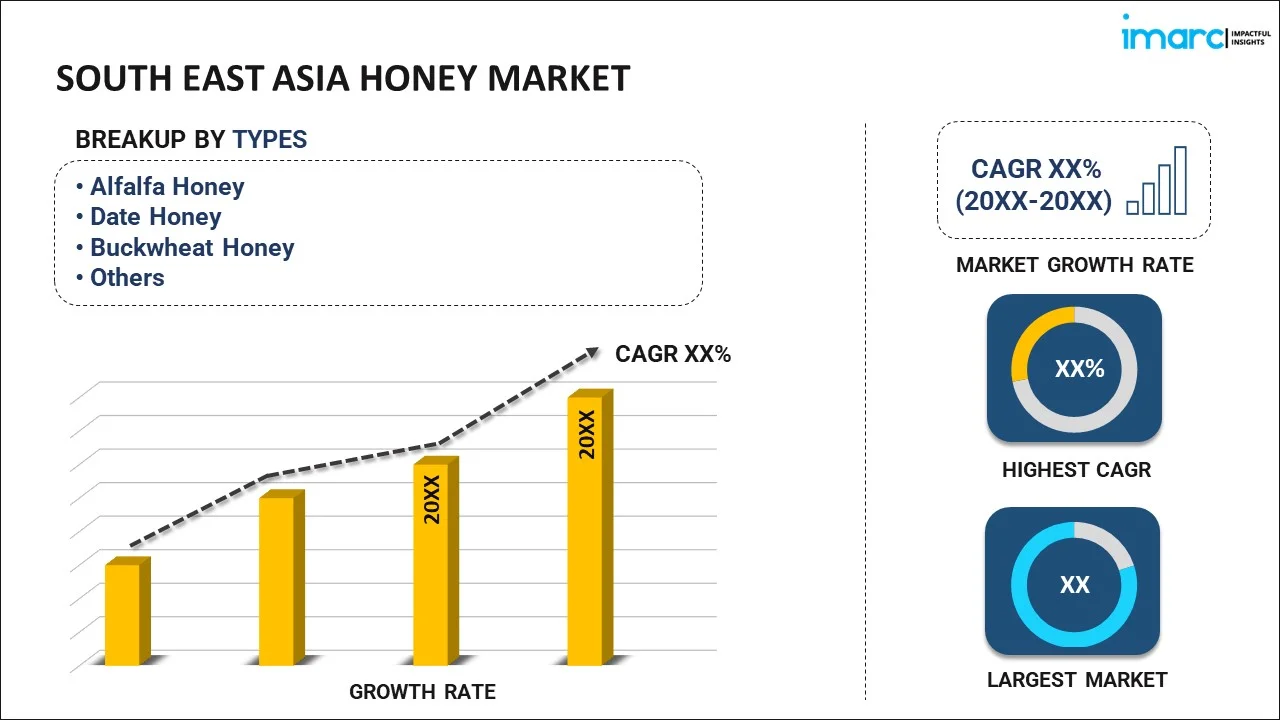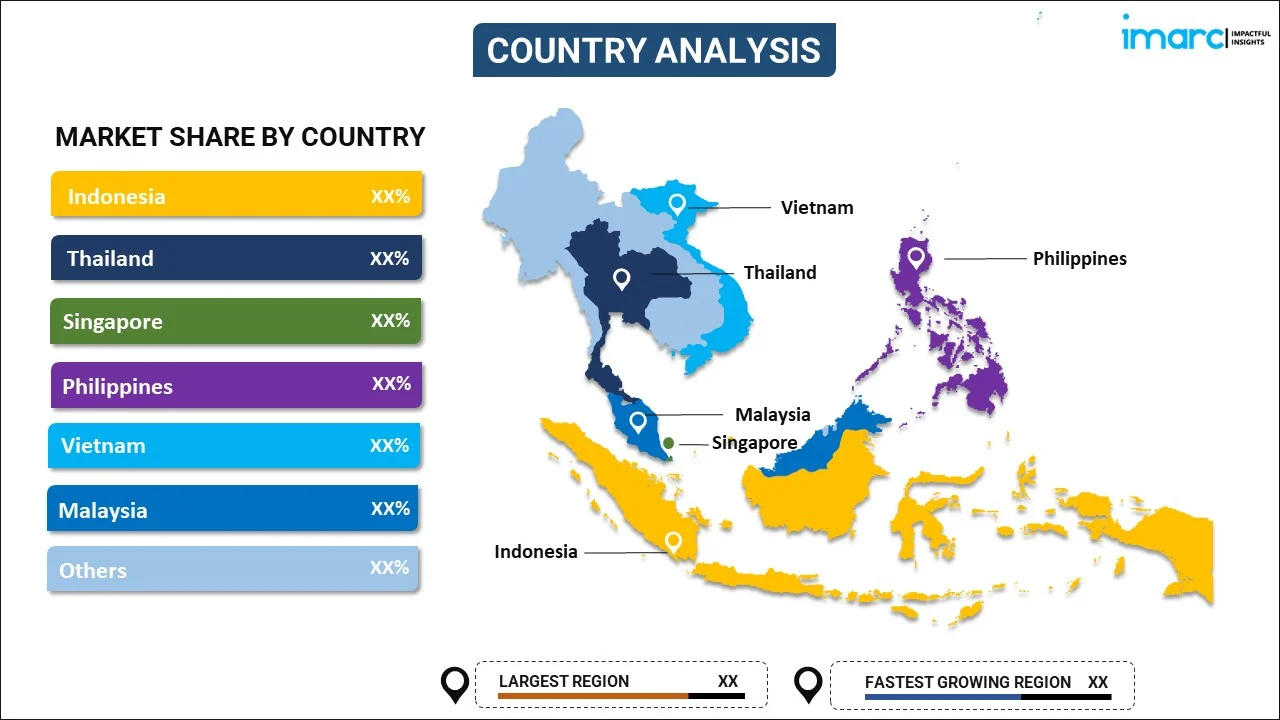
South East Asia Honey Market Report by Type (Alfalfa Honey, Date Honey, Buckwheat Honey, Acacia Honey, Clover Honey, Linden Honey, and Others), Distribution Channel (Supermarkets and Hypermarkets, Convenience Stores, Online Stores, and Others), Application (Food and Beverages, Personal Care and Cosmetics, Pharmaceuticals, and Others), and Country 2025-2033
Market Overview:
South East Asia honey market size is projected to exhibit a growth rate (CAGR) of 5.32% during 2025-2033. The growing number of health-conscious individuals who seek alternatives to refined sugars and artificial sweeteners is primarily driving the market growth.
|
Report Attribute
|
Key Statistics
|
|---|---|
|
Base Year
|
2024 |
|
Forecast Years
|
2025-2033
|
|
Historical Years
|
2019-2024
|
| Market Growth Rate (2025-2033) | 5.32% |
Honey stands as a naturally thick, sweet liquid created by bees through the conversion of flower nectar. It has been valued by humans for generations, appreciated not just for its delightful flavor but also for its diverse health advantages and adaptability. Honey comprises glucose, fructose, along with a range of minor vitamins, minerals, and antioxidants, rendering it a more nutrient-dense alternative compared to processed sugar. Its inherent antibacterial qualities have resulted in its application in wound treatment and traditional medicinal practices. Honey is available in a variety of hues and flavors, which are influenced by the specific types of flowers from which bees gather nectar.
South East Asia Honey Market Trends:
The South East Asia honey market is experiencing a notable upswing, buoyed by a burgeoning awareness of health and wellness among consumers. As people increasingly prioritize their health, they are actively seeking alternatives to artificial sweeteners and processed sugars, which is positively influencing the regional market. Honey, with its innate blend of sugars, vitamins, minerals, and antioxidants, is being perceived as a more wholesome choice. This market's growth is further propelled by the expansion of the beekeeping industry, which is contributing significantly to the overall market dynamics. Furthermore, the surging demand for distinct varieties of honey, driven by the growing consumption of specialty foods, is creating favorable prospects for the market. Besides this, the accessibility of these products through various online and offline organized retail platforms is fostering increased sales and visibility, which is acting as another significant growth-inducing factor. Notably, the market's expansion is also influenced by factors such as rapid urbanization, notable advancements in the food and beverage (F&B) sector, rising disposable incomes, and the active pursuit of research and development (R&D) endeavors undertaken by several key industry players. Furthermore, the introduction of distinct flavors that offer unique experiences is projected to fuel the regional market over the forecasted period.
South East Asia Honey Market Segmentation:
IMARC Group provides an analysis of the key trends in each segment of the market, along with forecasts at the regional and country level for 2025-2033. Our report has categorized the market based on type, distribution channel, and application.
Type Insights:

- Alfalfa Honey
- Date Honey
- Buckwheat Honey
- Acacia Honey
- Clover Honey
- Linden Honey
- Others
The report has provided a detailed breakup and analysis of the market based on the type. This includes alfalfa honey, date honey, buckwheat honey, acacia honey, clover honey, linden honey, and others.
Distribution Channel Insights:
- Supermarkets and Hypermarkets
- Convenience Stores
- Online Stores
- Others
A detailed breakup and analysis of the market based on the distribution channel have also been provided in the report. This includes supermarkets and hypermarkets, convenience stores, online stores, and others.
Application Insights:
- Food and Beverages
- Personal Care and Cosmetics
- Pharmaceuticals
- Others
The report has provided a detailed breakup and analysis of the market based on the application. This includes food and beverages, personal care and cosmetics, pharmaceuticals, and others.
Country Insights:

- Indonesia
- Thailand
- Singapore
- Philippines
- Vietnam
- Malaysia
- Others
The report has also provided a comprehensive analysis of all the major regional markets, which include Indonesia, Thailand, Singapore, Philippines, Vietnam, Malaysia, and Others.
Competitive Landscape:
The market research report has also provided a comprehensive analysis of the competitive landscape in the market. Competitive analysis such as market structure, key player positioning, top winning strategies, competitive dashboard, and company evaluation quadrant has been covered in the report. Also, detailed profiles of all major companies have been provided.
South East Asia Honey Market Report Coverage:
| Report Features | Details |
|---|---|
| Base Year of the Analysis | 2024 |
| Historical Period | 2019-2024 |
| Forecast Period | 2025-2033 |
| Units | Million USD |
| Scope of the Report | Exploration of Historical and Forecast Trends, Industry Catalysts and Challenges, Segment-Wise Historical and Predictive Market Assessment:
|
| Types Covered | Alfalfa Honey, Date Honey, Buckwheat Honey, Acacia Honey, Clover Honey, Linden Honey, Others |
| Distribution Channels Covered | Supermarkets and Hypermarkets, Convenience Stores, Online Stores, Others |
| Applications Covered | Food and Beverages, Personal Care and Cosmetics, Pharmaceuticals, Others |
| Countries Covered | Indonesia, Thailand, Singapore, Philippines, Vietnam, Malaysia, Others |
| Customization Scope | 10% Free Customization |
| Post-Sale Analyst Support | 10-12 Weeks |
| Delivery Format | PDF and Excel through Email (We can also provide the editable version of the report in PPT/Word format on special request) |
Key Questions Answered in This Report:
- How has the South East Asia honey market performed so far and how will it perform in the coming years?
- What has been the impact of COVID-19 on the South East Asia honey market?
- What is the breakup of the South East Asia honey market on the basis of type?
- What is the breakup of the South East Asia honey market on the basis of distribution channel?
- What is the breakup of the South East Asia honey market on the basis of application?
- What are the various stages in the value chain of the South East Asia honey market?
- What are the key driving factors and challenges in the South East Asia honey?
- What is the structure of the South East Asia honey market and who are the key players?
- What is the degree of competition in the South East Asia honey market?
Key Benefits for Stakeholders:
- IMARC’s industry report offers a comprehensive quantitative analysis of various market segments, historical and current market trends, market forecasts, and dynamics of the South East Asia honey market from 2019-2033.
- The research report provides the latest information on the market drivers, challenges, and opportunities in the South East Asia honey market.
- Porter's five forces analysis assist stakeholders in assessing the impact of new entrants, competitive rivalry, supplier power, buyer power, and the threat of substitution. It helps stakeholders to analyze the level of competition within the South East Asia honey industry and its attractiveness.
- Competitive landscape allows stakeholders to understand their competitive environment and provides an insight into the current positions of key players in the market.
Need more help?
- Speak to our experienced analysts for insights on the current market scenarios.
- Include additional segments and countries to customize the report as per your requirement.
- Gain an unparalleled competitive advantage in your domain by understanding how to utilize the report and positively impacting your operations and revenue.
- For further assistance, please connect with our analysts.
 Inquire Before Buying
Inquire Before Buying
 Speak to an Analyst
Speak to an Analyst
 Request Brochure
Request Brochure
 Request Customization
Request Customization




.webp)




.webp)












